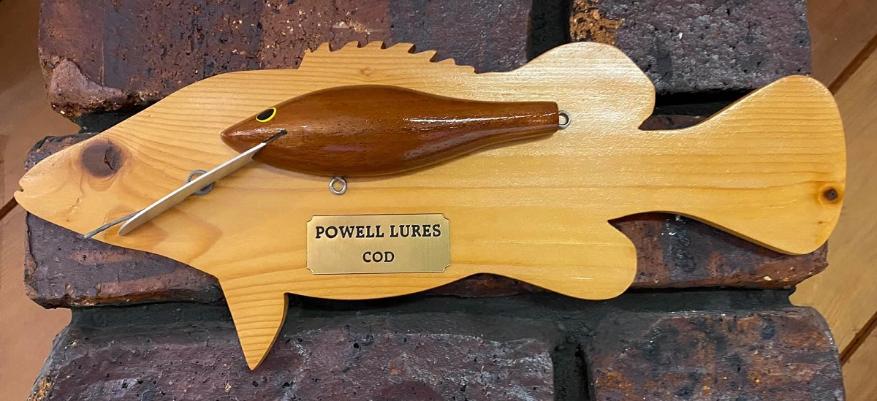Powell Lures - NSW:
Banner image shows a Powell lures 'Kaditcha' set with hat c.2013
Powell Lures - NSW:
The following article was written and supplied to Lure Hub OZ by Travers Powell maker of Powell Lures.
From the Beginning:
Born and bred at Harden, NSW, on a property called “Beggan Beggan”, the only fishing interests that I had, as a kid, was a frozen prawn on a hook while on holidays. In 1972, the old man sold the farm and bought a motel in Merimbula. I was at Uni, at the time, and fishing hadn’t entered the equation, even though I now lived on the coast. It wasn’t until the late 70’s, when I met a bloke who worked at Bluewater Sports Store, in Merimbula, that I got hooked on fishing. Michael McMaster was a mad keen sports fisherman and we spent many weekends flogging the Monaro trout streams, using Rapala and Rebel minnows on ‘spiderline’. We also fished the saltwater, but trout were our main target. Mike made my first ‘real’ rod – a Bushy (Kaj Busch) designed, pistol grip baitcaster. First runner was on the side and the others underneath. Bushy and Mike also inspired me to start fly fishing.The use of 1kg and 2 kg line resulted in a lot of lost lures, which created an interest in making my own. At that stage, I had no idea about making lures and tried whittling lures, with a pocket knife, out of solid pieces of pine. It was a hopeless task and no lures were created.

Travers Powell's first 'real rod'
In 1983, I went back to New England University, Armidale, to do a Diploma in Education. I found a fishing mate, who also was doing his Dip Ed, and we spent a lot of time fishing the New England trout streams. Chris Barker was from Parkes and was keen to make some trout lures. This is the time that I made my first lures that actually worked. They were basic, but some of them actually worked.
My first teaching position, in 1984, was Dunedoo Central School, as Agriculture teacher. It didn’t take long to discover the great trout fishing streams, only 30 minutes away, at Coolah. Within no time I was active in the Coolah Anglers Club, which was affiliated with the New England Trout Acclimatisation Society. In the Coolah Creek, 3lb Rainbows were common, 5lb Rainbows weren’t uncommon and my largest Rainbow was 7lb. I lost a lot of Rapalas and Rebels on 2 & 4 lb line, so there was a necessity to make a few lures. The woodwork room, at school, had a bandsaw and belt sander and I had read up on making lures, from magazine articles (Peter Newell’s article in Sept 1983 Modern Fishing) and books (Vic McCristal’s ‘Practical Fishing with Lures). My home made trout lures actually looked like lures and caught lots of trout.
In 1989, I moved to Tenterfield. I bought a house and went to the Royal Hotel to have a few celebratory beers with the agents, when I noticed Peter Newell propping up the bar. I introduced myself and we had a great chat about lures and fishing. Peter’s wife, Kathy, worked at the school, so it wasn’t long before I was in Peter’s workshop being shown his lures and how he made them. That was the start of a great friendship. Peter taught me how to make lures, using his method of carving lines and back-to-back blanks, in sizes that made my trout lures look microscopic. I spent a lot of time in Peter’s workshop. He not only showed me how to make the lures but he also made me lures as part of the training process. I still have a few of those original lures. Carving the lures from timber was not too difficult, but it took me a lot of time to master spraying them with acrylic lacquer. Many of my early lures were painted by Peter, because I was having problems with the spray painting process. When I was declared capable of painting my own lures, I bought a spray painting outfit. Peter was very generous with his time and resources. He gave me the templates to a number of his lures, including the Guppy, Kadaitcha and a lure that he called a Grunt. So these were the first lures that I made in Tenterfield. Peter also gave me a couple of boxes of Scorpion blanks, that ranged from untouched blanks through to fully carved and sanded blanks.
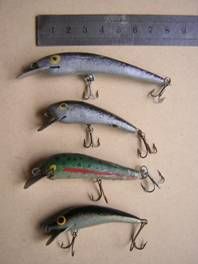
Above: 4 trout lures that I made sometime between 1983 and 1988
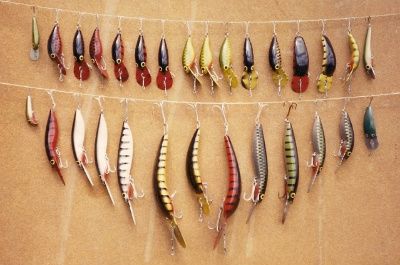
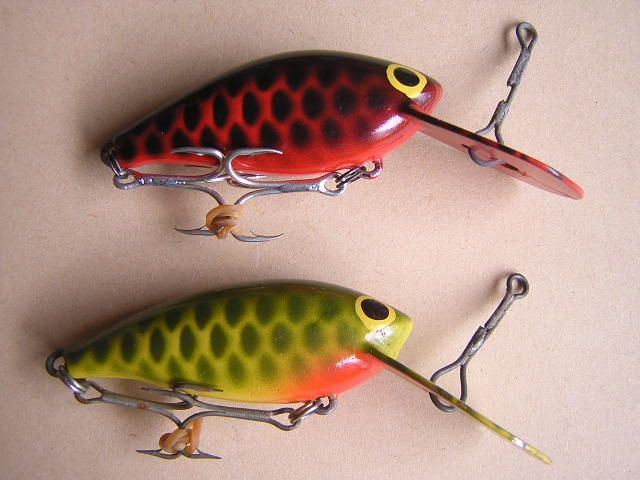
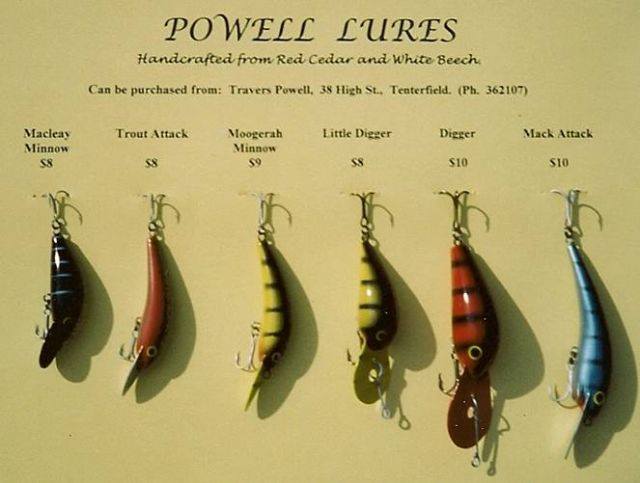
The lures that I made were solely for my own use and I had no intention of selling the lures. I was happy to lose lures on drowned trees in Glenlyon Dam, or snags in the rivers, then make replacements. That was until I bought a small tinnie, from Peter’s next door neighbour, and decided that I needed a depth sounder. The basic Humminbird sounder was about $400, which was a heap of dough in 1991. A mate bought the Deepwater Pub and asked me if he could sell my lures at the pub. That was when I thought that I’d sell a few and buy the Humminbird.. By this stage, I was making my own designed lures – the Guppy lure had been transformed into the shape of the current Digger range.
The model range from the Tenterfield days is shown left with the prices from the time.
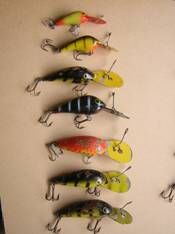
Photo above: Some old Diggers, a Little Digger and a Tiny Digger.
Right shows the earliest of cards for a 'Little Digger' and a 'Kaditcha' with the High St address in Tenterfield. The lures have hardly changed during the decades they have been made.
I later added new designs, but none of them had names. Harry Watson was selling heaps of my lures around Beaudesert, and demanded that I give them names to make it easier for him to take orders – the lures were named Digger, Little Digger, Tiny Digger, Trout, Moogerah Minnow and Macleay Minnow. Harry asked me to make him a lure to catch Mackerel off the Gold Coast and along came the Mack Attack. Bushy asked me to send him a couple of Mack Attacks for a Rex Hunt fishing trip to far north Qld – he gave me rave reviews on the lure. The Mack Attack has established a great reputation as a Barra lure, thanks to Bushy and my brother-in-law, who lived at Nhulunbuy for 5 years
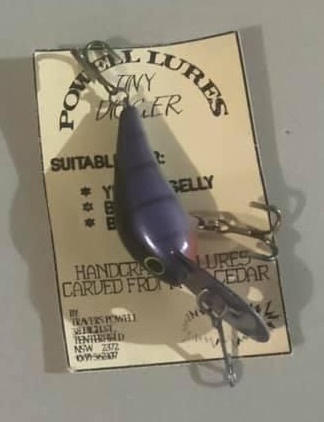
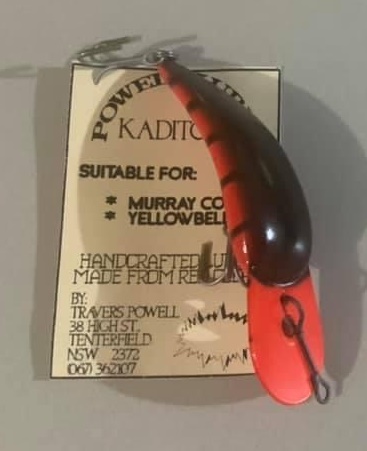
At Tenterfield High School, I ran “Fishing Clinic” classes, teaching students how to make lures. The 7cm Minnow Lure Making Kit is based on the lure that I taught the students to make.
In my last couple of years at Tenterfield, I started making two new lures. One was called Cod, because of it’s Cod-shaped profile and the other I hadn’t named. The ‘Cod’ lure caught my biggest yellowbelly (15lb) and proved to be an excellent river lure for cod and yellowbelly. I sold a fair few ‘Cod’ lures but stopped making them when I moved to Maitland in 1997. The un-named lure, was a yabby imitation, in the vane of the Mudbug/BigDig style of lure. It was still in the testing phase when I left Tenterfield, but was very effective on Cod and Yellowbelly.
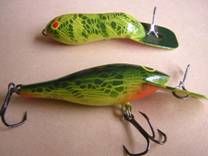
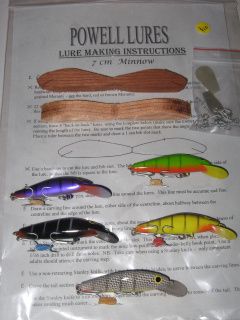
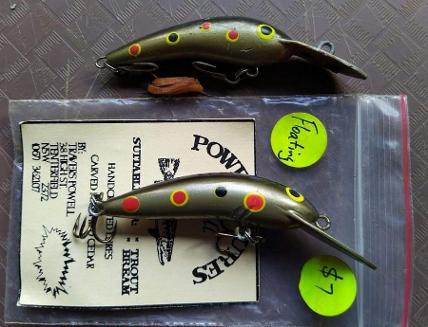
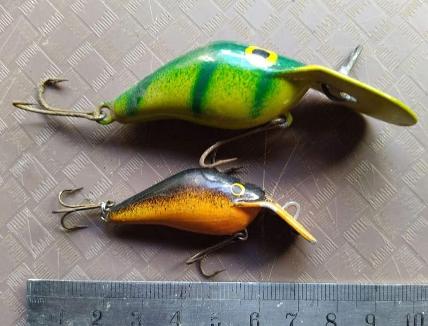
I moved to East Maitland, to take up the Agronomy Lecturer’s position at Tocal Agricultural College. Now I had to think about saltwater lures. My minnow-type lures were easily adapted to saltwater with a colour. The only new lure that I have developed, since moving to East Maitland, is the Micro Digger. It’s development came about because of the need for a deep diving Bream lure.
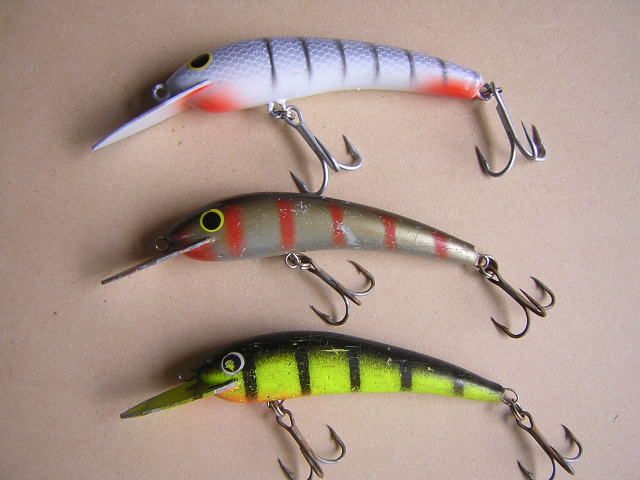
Top is a modern Mack Attack. Below are 2 original Mack Attacks
Since moving to Maitland, I have also put together a second lure making kit, based on the Guppy that Peter Newell first taught me to make.
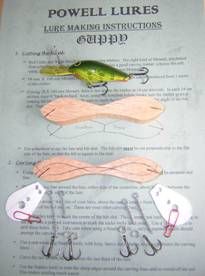
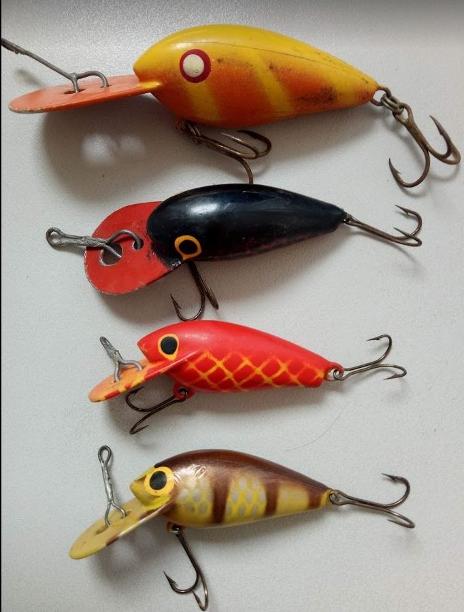
The lures featured here are some of Traver's early models that were sold in November, 2019 to raise much needed funds for the Rural Fire Brigade services during the catastrophic fires in Australia over several months from September and into December 2019. It was a very generous offer and all of these Powell Lures came from Traver's tacklebox and have caught fish and tell stories . . . note initialled with T.P and heavily influenced by Peter Newell's Guppy shape.
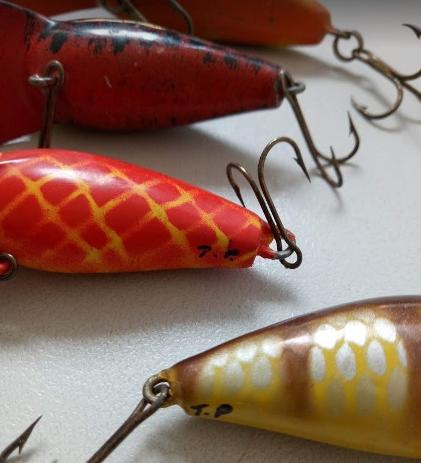
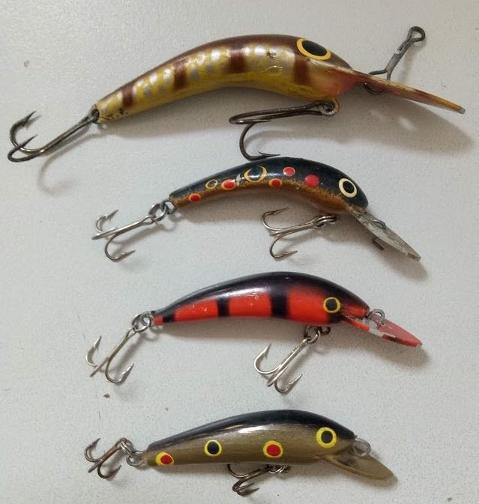
Early Powell lures were painted with spray cans before moving to more sophisticated spray apparatus and more complex patterns. The later patterns can be seen in this lot - hand painted trout spots and the characteristic thick black barred stripes emerging as a staple in the Powell patterns.
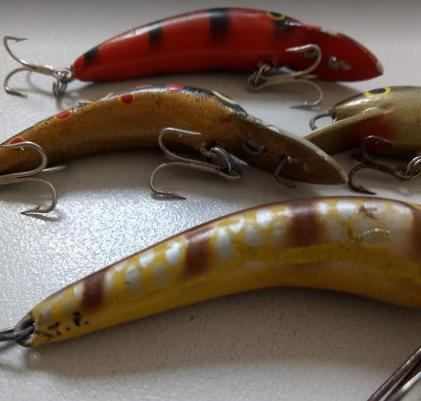
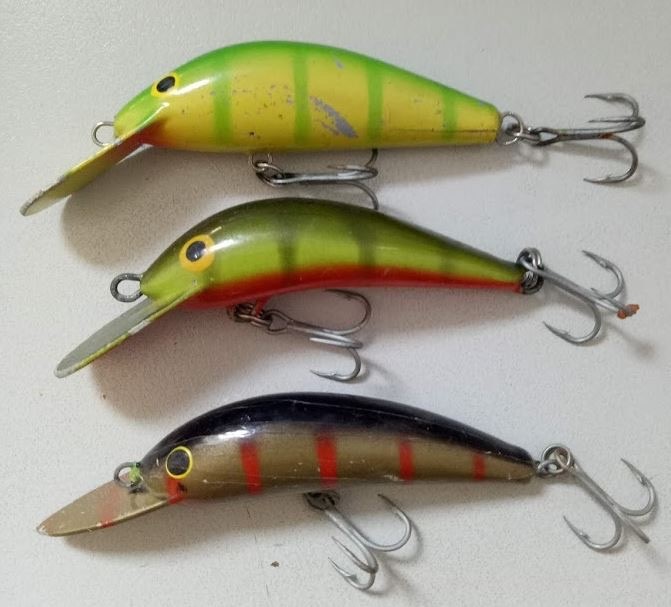
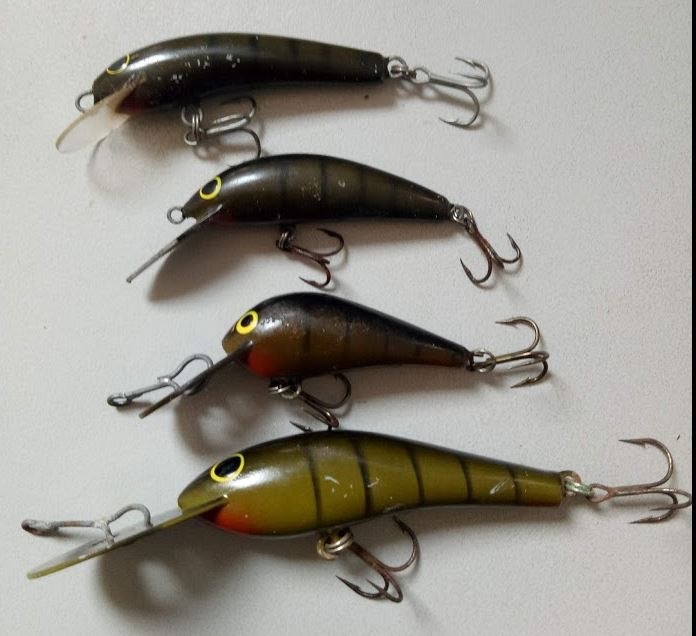
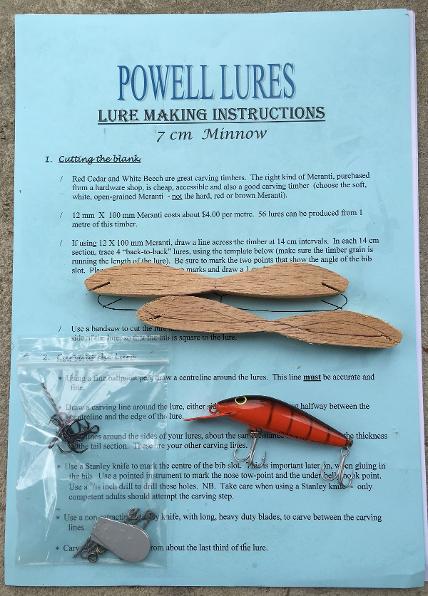
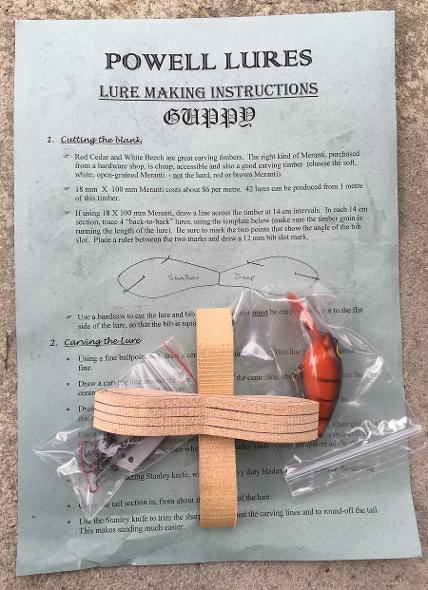
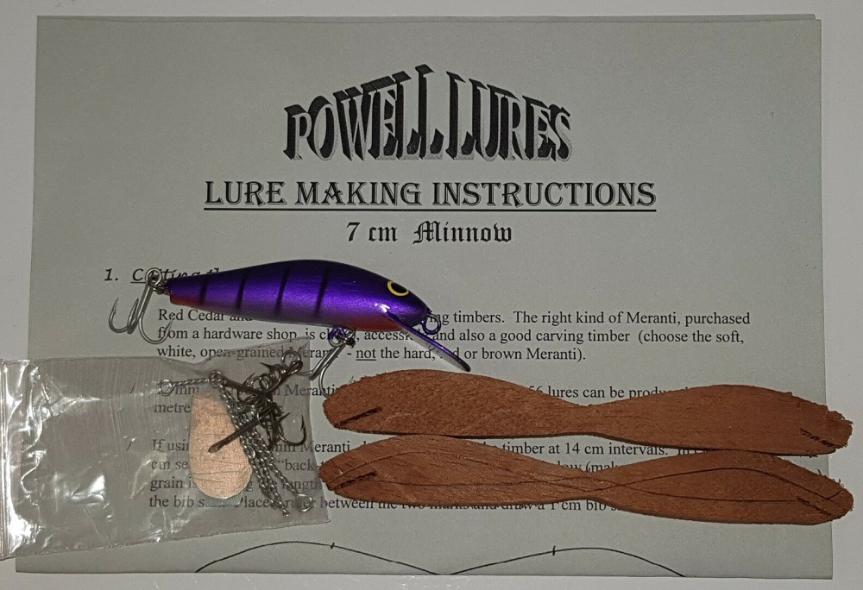
The lure making process is shown in Making a Lure Section
Australian Red Cedar has been the timber used in most of my lures. The cedar has come from various sources, but most of it came from 2 huge cedar doors that I bought when the original Tenterfield School buildings were renovated and from a renovation job that my father-in-law did on the Railway Hotel, in Armidale, about 30 years ago. The original Tenterfield School was built in 1887 and the Railway Hotel was built in 1878, so the cedar used in my lures is very old and has a little bit of history attached to it. I use white beech and brown beech, when I can get it. I use meranti in the lure making kits, because the soft, white meranti is like balsa to carve – easy for new lure carvers to manage
My biggest selling lure is the Macleay Minnow, for bass fishing. Heaps of them have been sold to fisherman in Armidale and Walcha as well as local and, more recently, Western Sydney. They are deadly on bass, with anglers ordering up to 30 lures at a time.
Without doubt, my favourite lure to fish with is the Little Digger. It casts well and has a strong action, giving great feedback through the rod tip. It’s a proven cod & yellowbelly lure.
Photo below: Little Diggers
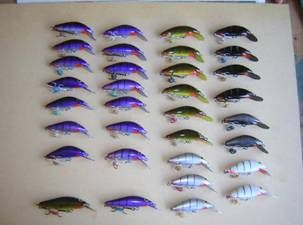
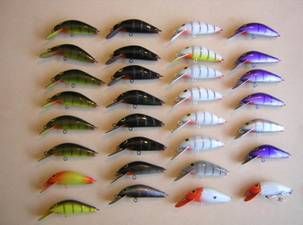
Photos above: Macleay Minnow orders for Western Sydney bass fisherman
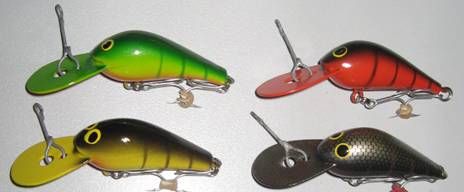
I have chosen to remain a small time, “cottage industry”, lure maker (I make about 150-250 lures each year) because I don’t have the spare time to make large quantities of lures. Also, Peter Newell advised me to remain small and to avoid the dramas that he had with customers and other lure makers. I have never marketed my lures, preferring to sell them from home, through friends and relatives and from a stall that I have at the Maitland Caravan, Camping, 4WD, Fish and Boat Show (May). In recent times, I have tried selling lures on ebay.
All of my lures are hand carved, mostly from very old Australian Red Cedar, using the methods that Peter Newell showed me in 1989. Peter has passed on, so I would like to maintain his traditional lure carving methods, to preserve the craft and as a sign of respect for his help and friendship. To help continue the craft of hand carving lures, the “Peter Newell” way, I have put together two lure making kits. One is the 7cm Minnow and the other is the Guppy. Hopefully, these will help to start a new generation of lure carvers.
My lures are now being sent to all parts of Australia. Some people approached me to make them Kadaitchas, which, at first, I was hesitant to do. Peter was always happy for me to make Kadaitchas, and I only made them for my own use. When people asked to buy them from me, I would explain that they weren’t my lure to sell – Peter found this amusing and said that he had no problems with me selling them. Prior to 2009, I had only sold about 20 Kaditchas in the 20 years since Peter gave me the templates and showed me how to make them. I explained to those enquiring that I had too much respect for Peter to exploit his passing, but agreed to make the Kaditcha in very limited numbers. In 2009, I made 10 sets of 2” and 3” Kaditchas and sold 8. In 2010, I made 15 sets and sold 13, keeping the first 2 sets, in both years, for family members. The Kaditchas will only be made in very limited numbers each year.
Innovation and new designs? Most lure makers seek to develop a unique design. I’m no different, but I am content to continue making lures that are proven fish catchers. Sometimes, it’s little things that matter. For example, in the early 90’s lure makers were trying to put lumps and bumps into their lures to prevent the trebles linking together. I fixed the problem by turning the rear eyelet (hook hanger) 90 degrees, so it was horizontal rather than vertical – problem solved. The small top eyelet on my bib tows, I turned 90 degrees, in the belief that it would help the Tackleback attach to the lure better. Lack of time is a major factor that prevents me experimenting with new designs, so the Little Digger, Micro Digger, Mack Attack, Moogerah Minnow, Macleay Minnow and Trout, plus the 2 Lure Kits, is where I’m at in 2010.
I’m in the process of making some of the old lures that I used to make in Tenterfield – a kind of retro-collection – which may be of interest to anglers. So that’s it – a fairly simple story. Started making lures to replace lures lost to fish and snags. Ran into a bloke called Peter Newell and started making really good quality lures, still to replace those lures lost to fish and snags. An opportunity came to sell a few lures in the early 90’s and, 17-18 years later, I’m still making them in relatively small quantities - so there should be about 3000-4000 Powell Lures hanging off drowned trees/snags and in the bottom of tackle boxes, somewhere.
Travers Powell, 3/4/2010
The following photos showcase some of the Powell special edition sets and newer models
